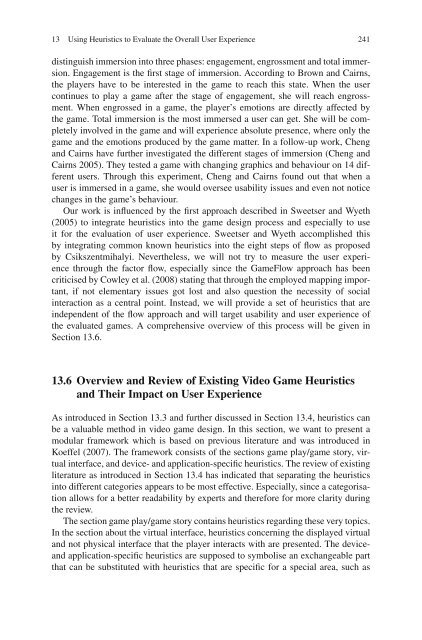Evaluating User Experience in Games: Concepts and Methods - Lirmm
Evaluating User Experience in Games: Concepts and Methods - Lirmm
Evaluating User Experience in Games: Concepts and Methods - Lirmm
You also want an ePaper? Increase the reach of your titles
YUMPU automatically turns print PDFs into web optimized ePapers that Google loves.
13 Us<strong>in</strong>g Heuristics to Evaluate the Overall <strong>User</strong> <strong>Experience</strong> 241<br />
dist<strong>in</strong>guish immersion <strong>in</strong>to three phases: engagement, engrossment <strong>and</strong> total immersion.<br />
Engagement is the first stage of immersion. Accord<strong>in</strong>g to Brown <strong>and</strong> Cairns,<br />
the players have to be <strong>in</strong>terested <strong>in</strong> the game to reach this state. When the user<br />
cont<strong>in</strong>ues to play a game after the stage of engagement, she will reach engrossment.<br />
When engrossed <strong>in</strong> a game, the player’s emotions are directly affected by<br />
the game. Total immersion is the most immersed a user can get. She will be completely<br />
<strong>in</strong>volved <strong>in</strong> the game <strong>and</strong> will experience absolute presence, where only the<br />
game <strong>and</strong> the emotions produced by the game matter. In a follow-up work, Cheng<br />
<strong>and</strong> Cairns have further <strong>in</strong>vestigated the different stages of immersion (Cheng <strong>and</strong><br />
Cairns 2005). They tested a game with chang<strong>in</strong>g graphics <strong>and</strong> behaviour on 14 different<br />
users. Through this experiment, Cheng <strong>and</strong> Cairns found out that when a<br />
user is immersed <strong>in</strong> a game, she would oversee usability issues <strong>and</strong> even not notice<br />
changes <strong>in</strong> the game’s behaviour.<br />
Our work is <strong>in</strong>fluenced by the first approach described <strong>in</strong> Sweetser <strong>and</strong> Wyeth<br />
(2005) to <strong>in</strong>tegrate heuristics <strong>in</strong>to the game design process <strong>and</strong> especially to use<br />
it for the evaluation of user experience. Sweetser <strong>and</strong> Wyeth accomplished this<br />
by <strong>in</strong>tegrat<strong>in</strong>g common known heuristics <strong>in</strong>to the eight steps of flow as proposed<br />
by Csikszentmihalyi. Nevertheless, we will not try to measure the user experience<br />
through the factor flow, especially s<strong>in</strong>ce the GameFlow approach has been<br />
criticised by Cowley et al. (2008) stat<strong>in</strong>g that through the employed mapp<strong>in</strong>g important,<br />
if not elementary issues got lost <strong>and</strong> also question the necessity of social<br />
<strong>in</strong>teraction as a central po<strong>in</strong>t. Instead, we will provide a set of heuristics that are<br />
<strong>in</strong>dependent of the flow approach <strong>and</strong> will target usability <strong>and</strong> user experience of<br />
the evaluated games. A comprehensive overview of this process will be given <strong>in</strong><br />
Section 13.6.<br />
13.6 Overview <strong>and</strong> Review of Exist<strong>in</strong>g Video Game Heuristics<br />
<strong>and</strong> Their Impact on <strong>User</strong> <strong>Experience</strong><br />
As <strong>in</strong>troduced <strong>in</strong> Section 13.3 <strong>and</strong> further discussed <strong>in</strong> Section 13.4, heuristics can<br />
be a valuable method <strong>in</strong> video game design. In this section, we want to present a<br />
modular framework which is based on previous literature <strong>and</strong> was <strong>in</strong>troduced <strong>in</strong><br />
Koeffel (2007). The framework consists of the sections game play/game story, virtual<br />
<strong>in</strong>terface, <strong>and</strong> device- <strong>and</strong> application-specific heuristics. The review of exist<strong>in</strong>g<br />
literature as <strong>in</strong>troduced <strong>in</strong> Section 13.4 has <strong>in</strong>dicated that separat<strong>in</strong>g the heuristics<br />
<strong>in</strong>to different categories appears to be most effective. Especially, s<strong>in</strong>ce a categorisation<br />
allows for a better readability by experts <strong>and</strong> therefore for more clarity dur<strong>in</strong>g<br />
the review.<br />
The section game play/game story conta<strong>in</strong>s heuristics regard<strong>in</strong>g these very topics.<br />
In the section about the virtual <strong>in</strong>terface, heuristics concern<strong>in</strong>g the displayed virtual<br />
<strong>and</strong> not physical <strong>in</strong>terface that the player <strong>in</strong>teracts with are presented. The device<strong>and</strong><br />
application-specific heuristics are supposed to symbolise an exchangeable part<br />
that can be substituted with heuristics that are specific for a special area, such as

















